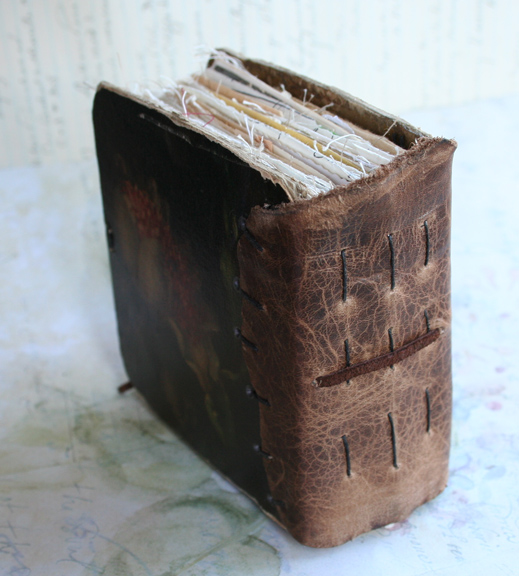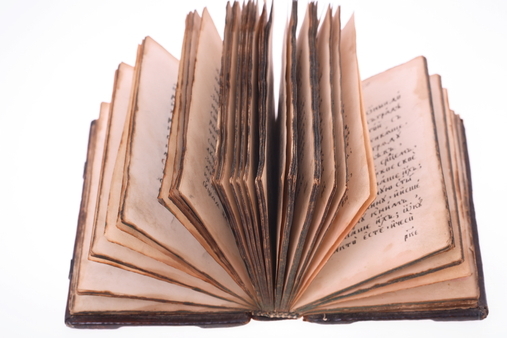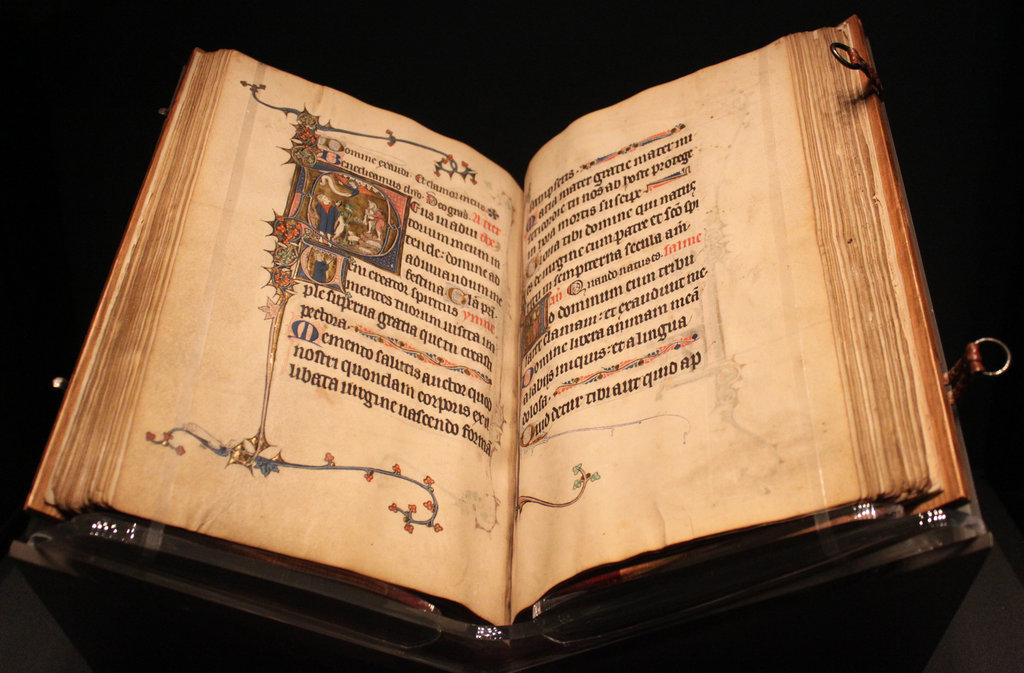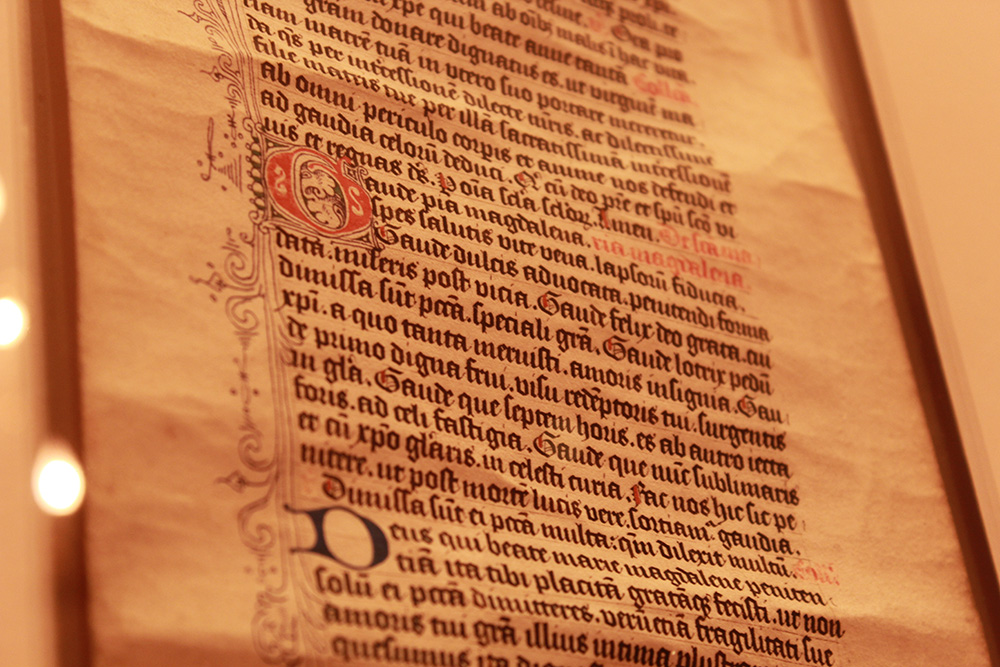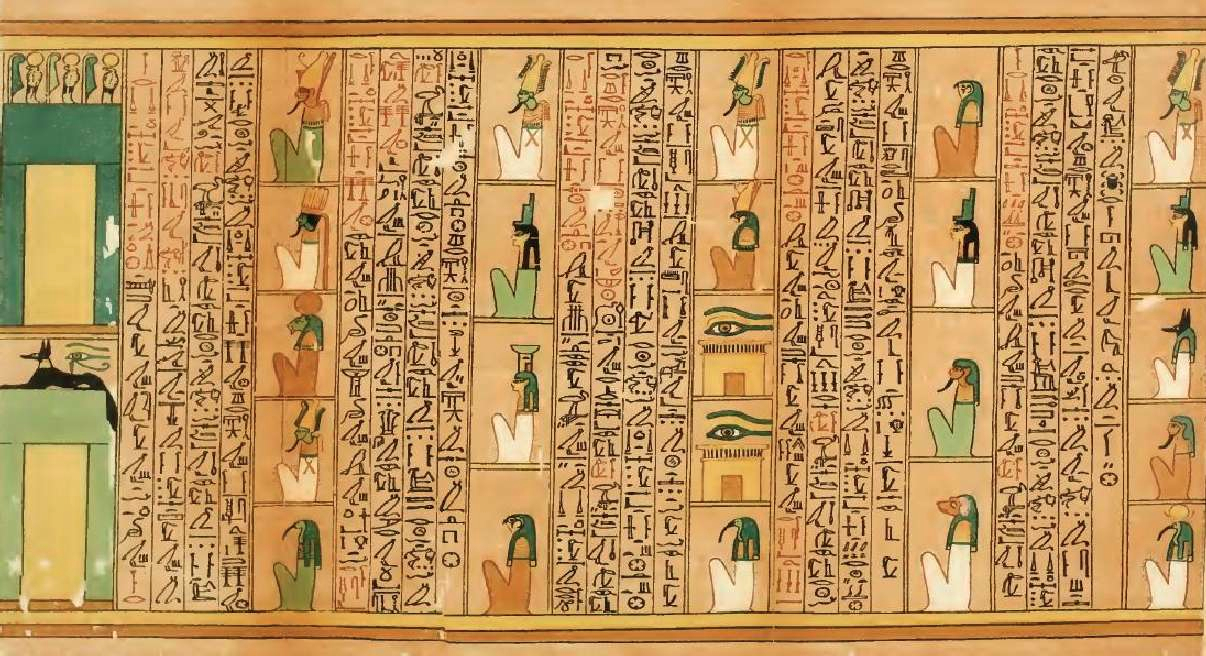Three books and a set of scrolls found from a storage room in Penhew Foundation’s basement:
YE BOOKE OF COMUNICACIONS WITH YE ANGEL DZYON (ARCHAIC ENGLISH)
PHYSICAL DESCRIPTION:
Leather bound manuscript, 18” x 11½” (medium folio), slightly damaged with some foxing and occasionally irregularly sized pages. No title or author is given on the cover but a frontispiece identifies it as Ye Booke of Comunicacions with ye Angel Dzyon. The manuscript contains text in archaic English and an unknown set of symbols as well as marginal notes in what appears to be Greek.
CONTENTS AFTER QUICK SKIMMING:
This book is a loosely organized collection of what can be described, for lack of a better term, as séances between an unnamed medium and an “angelic spirit” identified in the text as Dzyon (or sometimes as Dzyan). The sessions are supposed to transcribe the wisdom of Cehuti, an archangel (?), and are composed of a mixture of divine pre-history, angelic law and magic, confounding cabalistic discussions, and suggestive discussions of how certain humans may be elevated to divinity. The papers that form the text seem to have been collected and organized along specific themes and not chronologically. Some of the portions in the non-English symbols appear to be written contemporaneously with the regular writing but not in the same hand.
The work itself is confused and sometimes self-contradictory. While portions of the English text seem to be translations of the two types of ciphers used, other portions are left untranslated. Certain sections, particularly those dealing with incantations, are heavily annotated in Greek.
QUOTES:
Casting againe into ye Shew Stone, ye Angel spake, saying unto me much of what passed in long-sunk Atlantis and is spoke of by Cehuti. In those days ye Nephilim walked ye land and payed obeyance to one such as Glune, crowned in laurels and fearful to behold and served by great beasts whose bodies were like a flower with ye head of a serpent. Another angel revered as ye father of this race was Dowlot, who wove ye fibers of creation and undoes them at God’s command, and his mark is ye crystal rod he carries which bearest three sides and is yet round. Ye might of these men was great and they knew much of magic…
— — — — —
When ye song is played again under winter sky ye one [the Black Bird of the Anemoi] will come to ye learned practicioner. Ye bird subsisteth upon carrion flesh and must be appeased before it will labor at your behalf. Ye hunger of such a one can be slaked with ye body of a single child but it is a cruel servant and will oft clamour for more. Be not hesitant to fulfill such whims as it may carry ye unwary summoner aloft if displeased. When it flies with belly-full it can be of great aid to ye subtle magician and can travel many leagues without tiring.
— — — — —
[Be wary! The one who slumbers is a spirit of the greatest darkness. Call not upon him for the price he demands far exceeds the rewards he grants. Lest ye wish to arouse such a one who dwells in sea-dark chambers and whose very tread maketh the rocks tremble, practice such rites as these at your own peril. Pay heed to one who has suffered much from what he hath seen because his grasp exceedeth his wisdom. My dreams are grave troubled still, years on from such folly, and I fear gravely His eye remaineth upon me still.]
THE G’HARNE FRAGMENTS (ENGLISH)
PHYSICAL DESCRIPTION:
A slim, unadorned, pasteboard-bound work in mediumsixteenmo; 4 ½” wide by 5 ¾” high; 128 pages. The title is printed on both the pasteboard cover (a pale cream, with black ink) and the spine, with the author’s name (Sir Amery Wendy-Smith) printed below the title. No publisher is listed nor is a date of publication given. The production quality and style suggests a small university press or that the author paid for publication himself; the finished product is of inexpensive materials. There are numerous illustrations depicting some sort of cipher or artificial language consisting of haphazardly arranged dots and a scattering of astronomical charts. A hand-written dedication on the title page says “Many thanks for your advice and aid, W-S.” Scattered throughout the text are a few passages underlined in meticulous pencil lines.
CONTENTS AFTER QUICK SKIMMING:
This work provides a supposed translation of inscriptions first discovered by British explorer Sir Howard Windrop in a hitherto unknown ruined city in Africa, referred to as “G’harne” by the author. Expanding on Windrop’s earlier translation, Wendy-Smith, claims that the text contains the fragmentary records of a prehistoric, (perhaps even non-human) civilization. Included in the text is an incomplete catalog of the various cities of this unknown civilization (including G’harne) as well as discussions of the cities of other increasingly fanciful civilizations and races. A lengthy passage discusses the fall of the city after the collapse of G’harne’s builders’ civilization and how the survivors were besieged by a race of subterranean creatures. Eventually the city’s builders were able to trap their attackers via some powerful enchantment.
A short chapter presents a labyrinthine catalog of earlier wars between the builders of G’harne and a myriad of implausible races. Another section presents fragmentary star-charts and a catalog of the planets of our own solar system, including a body between Mars and Earth, as well as a host of worlds lying beyond Neptune. A final chapter discusses the city of G’harne itself, as described by Windrop1; a collection of vast, mammoth, eons-old stone blocks worn down by time and forgotten and mostly shunned by the local peoples. Wendy-Smith (like Windrop) never explains by what means he was able to translate the writings of this lost civilization, saving that for a promised future book to be written upon his return from a new expedition to G’harne.
QUOTES:
The third body is the greatest of the home sites in this region of all things, bearing much of worth to our people and in great settlements we inhabit it, sharing much of the southern lands though at time we made war with those we found there or who came after our arrival. The Nath Spheres proved of great worth after the coming of the [untranslatable] and his offspring, laying low his lands and driving them beneath the greatest of waters. Those who built upon the outer worlds pay us great heed and do not long stay upon this our claim and other native animals pay heed.
– – –
In distant ages this attack would have been stopped by the power we control but after the rising of the enslaved ones we were greatly diminished. The great rock worms, lead by [untranslatable, but according to local tribes the leader of the “rock worms” is the being called Shudde M’ell (he who shakes the earth from below)] fears not our tools and trapped the few who remained within the interior of the city. By plan, these unworthy beings were drawn into the great chambers beneath and were trapped by means of the [?] sign, the shape of which carries potent strength. In this way we have bound him and his children here, until such a time that our people are revitalized and can return the amorphous ones into bondage and return to punish those who sought to overthrow our dominion.
– – –
The local mganga who collect the star-stones do say that for a time the site of G’harne was inhabited by a degenerate race of men who came from a distant land. They made sacrifices to the great worms dwelling there and lived in great filth and corruption. They awaited a time when their god, who they called the King of Night, would come from the land of the great water, after being freed from his tomb of stone topped by stones, and lead them back to rule there forever. These terrible men, said not to be of any tribe, lived there for many ages until they were gathered by two princes, one from the north and one from the east, who carried them forth for reasons unknown, perhaps as slaves. This god, the King of the Night (sometimes called the Black King or Lord), is also known as the God of the Bloody Tongue, the God of the Black Wind (by tribes in the Kenya Colony), the Spiraling Worm (in the Belgian Congo), Ndura Oteba, the Sender of Great Illness (Somaliland and Abyssinia). My research indicates that it is a common figure in many African mythologies and seems to show a remarkable diffusion of an obscure Egyptian divinity called ‘Nyarlathotep’.
LIBER IVONIS (LATIN)
PHYSICAL DESCRIPTION:
A large (25” x 36”) vellum manuscript bound in brass-capped leather. The interior of the work (entitled Liber Ivonis) is in illuminated Latin, accompanied by copious marginal illustrations, miniatures, and decorated initials (most of which seem to consist of a rather fanciful toad or frog). The manuscript binding is in fair condition—some of the brass fittings have been lost, the inside cover has been gouged repeatedly (apparently to remove a book plate, the scraps of which remain, but are totally illegible), and there are recent small scorch marks on the rear cover. The manuscript interior is in excellent condition. The artwork within depicts many strange scenes, some of which are rather disturbing and unlike those found in a typical medieval work. An expert can date the manuscript to the early 13th century, most likely the Sicilian Court of Frederick II. The cover is more recent, probably dating from the early 16th century.
SET OF 15 SCROLLS:
PHYSICAL DESCRIPTIONS:
Six Arabic (A) scrolls:
A1—A fine linen scroll in Arabic, about five inches across, tied with a faded red silk ribbon. It can be dated to the 15th century, most likely originating in Egypt or possibly Tunis. The Arabic text is stylized and illuminated, and the scroll is in excellent condition.
A2—A cracked, partially fire-damaged, piece of parchment, about 15 inches across, mounted on a wax tablet (a method used to preserve particularly fragile texts). The text is in a very shaky hand and can be dated to the 9th century, most likely from Moorish Andalusia.
A3—A vellum scroll in Arabic, about 8 inches across, tied with a faded red silk ribbon. It can be dated to the early 12th century, almost certainly to Egypt.
A4—A papyrus scroll in Arabic, about 8 inches across, untied. It dates from the 8th century, though the writing style is somewhat antique (stylistically similar to the style of the previous century), suggesting the possibility that the author or scribe was from a provincial region, probably in the Arabian Peninsula.
A5—A vellum scroll in Arabic, about 8 inches across, tied with a faded red silk ribbon. The script and material suggests the work is of Egyptian origin, probably mid 15th century.
A6—A badly decayed papyrus scroll, probably from the middle of the early Fatimid Caliphate (10th century).
Four Latin (L) scrolls:
L1—Fragments of a papyrus scroll, written in Latin, pressed between thin glass plates and mounted in a booklet. The language suggests it was written around the time of the early Roman Empire (30-40 A.D.).
L2—A worn vellum scroll in Latin, about 12 inches across, tied with a linen cord. The script suggests it was written in the 12th century; a note at the beginning is in period ecclesiastical Latin while the bulk of the text is in late Imperial vernacular (probably 4th century). Fragments of a leaden seal bearing the image of a lion are preserved.
L3—A parchment scrap with Latin writing, uneven but between 7 and 8 inches across though it tapers at one end due to tearing or breaking. The language and the script used suggest an early medieval author, possibly in the late 8th century, most likely from the Carolingian court.
L4—Linen paper scroll in Latin, about 11 inches across, untied. The language is very late Medieval Latin, and is heavy with Italian vernacular. It probably comes from Northern Italy, possibly Milan, and dates to late 15th or early 16th century.
Two Egyptian Hieroglyphs (H) scrolls:
H1—A papyrus scroll in Hieratic Egyptian, about 10 inches across, mounted on a wax board. It probably dates from the 19th Dynasty (about 1200 B.C.).
H2—A papyrus scroll in Hieratic Egyptian, about 10 inches across, tied with a faded red silk ribbon. It dates from the Tanite (21st) Dynasty (about 1000 B.C.).
Two Medieval French (F) scrolls:
F1—A brittle vellum scroll in Langues d’Oïl (Old French), about 10 inches across, untied, dating to the later 11th century.
F2—A fine parchment scroll in Middle French, about 15 inches across; illuminated, illustrated, and tied with a black silk ribbon laced with threads of silver. It dates to the mid 16th century, probably from the court of Francis I.
One Old English (E) scroll:
E1—A brittle vellum scroll, about nine inches across, tied with a strip of hide. An expert could date the scroll to around 1050 AD, making it a remarkable and rare find.

